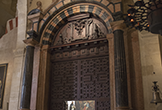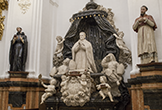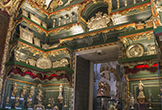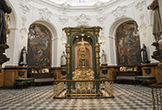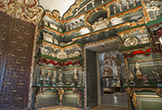After finishing the patronage period by the De Castro family over the Chapel of San Martín, and together with the fact that the rights over the Chapel of San Andrés belonged to the Cathedral Chapter, the space was donated to Cardinal Salazar to build his Chapel of Santa Teresa and future mausoleum. The Cardinal, Bishop of Córdoba between 1686 and 1706, was a very relevant man in the life of our city. In fact, we still preserve several works sponsored by him, such as the Hospital of the Cardinal Salazar, which is today the Faculty of Philosophy and Arts, or the Church of San Pedro de Alcántara.
Francisco Hurtado Izquierdo, senior master of the Cathedral, was in charge of designing it and the works started in 1697. The master designed an octagonal space covered by a vault, divided in eight spaces, whose ribs are decorated with flower motifs. Over it, there is a wide tambour with several windows, all of which are crowned by parted triangular pediments. The white colour of the wall coverings, together with the fine Baroque plasterwork, give this unique space a special personality, confering at the same time an even greater heterogeneity to the ensemble of the old Mosque, now Cathedral.
Just when entering the chapel, on the right, we can see the “Sepulchre of Cardinal Salazar“, also designed by Hurtado Izquierdo. However, it was made between 1709 and 1710 by the sculptors Teodosio Sánchez de Rueda, Domingo Lernico and Juan Prieto. It is thought that Hurtado Izquierdo could have been inspired in the models by Bernini in Roma, but they did not reach that quality. He used black marble for the architecture, such as the pedestal and the canopy, and white marble for the sculptures, where the praying figure of the Cardinal must be highlighted.
Teodosio Sánchez de Rueda carved the altarpiece of Santa Teresa, which was originally at the front of the chapel. However, this was substituted by the current one, which is neoclassical. Made in stucco, it rests over a Tabernacle decorated with a relief of “The Pieta” in bronze by Virgilio Castelli, who was asked to come from Italy for this purpose. Over it, we can see a sculpture of “Santa Teresa” made in polychrome wood by José de Mora Expósito, from Granada, in 1705. The Saint elegantly receives the Holy Spirit in the shape of a dove as Doctor of the Church. The rest of the sculptures in the room are also works by the artist from Granada, such as San Agustín, San Pedro Nolasco or San Francisco de Asís…
Acisclo Antonio Palomino decorated the Chapel of Santa Teresa with three large canvases representing three emblematic episodes of the religious history of the city: “The appearance of Saint Raphael before Father Roelas“, “San Acisclo and Santa Victoria” and “The Conquest of Córdoba by Fernando III the Saint“, painted around the year 1713. The two remaining canvases, located over the doors acceding the Crypt and the Treasure, represent “The Immaculate Conception” and “The Assumption of Mary“, both with luxurious frames by Teodosio Sánchez de Rueda.
In the centre of the chapel, we can find the “Monstrance” made by the German goldsmith Enrique de Arfe, a real piece of jewellery of the Treasure of the Cathedral. Casted and engraved in silver between the years 1514 and 1518, it represented a new understanding of the processional goldsmithing in our country. It is 2.62 metres high, of which 40 cm respond to the restorations and extensions carried out between the 16th and 18th centuries, while it is around 0.92 metres wide in its base.
The two entrances mentioned before, on the left and right, lead us to the Crypt and the Treasure respectively. The Crypt, thought as a burial location for the Cardinal’s family, was covered by a vault decorated with plasterwork, and its walls were covered with canvases by the painter Juan Pompeyo: “Appearance of the Virgin before San Fernando“, “The Martyrdom of San Zoilo“, “San Eulogio” and “The transverberation of Santa Teresa“. The Treasure, apart from the mentioned “Monstrance” by Arfe, is displayed in two rectangular rooms, and we could highlight the “Cross of Bishop Manrique” or the “Image of Our Lady“, by Damián de Castro, inspired in an original wooden work by Pedro Duque Cornejo.
If you wish to know the Chapel of Santa Teresa and the Treasure of the Mosque-Cathedral, do not hesitate to hire one of our guided tours. We are experts in the interpretation of the historic heritage from Córdoba. If you have chosen to do sightseeing in Córdoba, choose a high quality option, choose ArtenCórdoba.
Text: J.A.S.C.
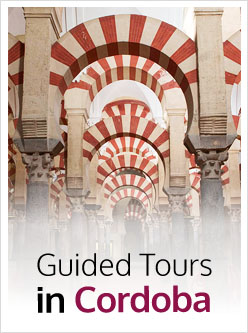

All the information about the monuments, festivals and places of interest in Cordoba… at a click!
If you want more information about the monuments of Cordoba, before doing your guided tours, here is the most complete guide, written by the tour guides and historians of our team
Over 2,000 items!
Mosque-Cathedral
Medina Azahara
Alcazar of the Christian Kings
Synagogue
The Museums
The Coutyards

All the information about the monuments, festivals and places of interest in Cordoba… at a click!
If you want more information about the monuments of Cordoba, before doing your guided tours, here is the most complete guide, written by the tour guides and historians of our team
Over 2,000 items!





